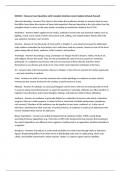RMC201 - Glossary Exam Questions with Complete Solutions Latest Update (Already Passed)
Aberrant decoding - Answers This refers to the notion that audiences decode or interpret texts in ways
that differ from those the creators of these texts expected. Aberrant decoding is the rule rather than the
exception when it comes to the mass media, according to semiotician Umberto Eco (1976).
Aesthetics - Answers When applied to the media, aesthetics involves the way technical matters such as
lighting, sound, music, kinds of shots and camera work, editing, and related matters intexts affect the
way audience members react to texts.
America - Answers In my discussion of focal points in Chapter 4, I use America because the alliteration
helps readers remember the focal points, but I could have used any country. America is one of the focal
points along with art (text), audience, artist (creator), and medium.
Archetype - Answers According to Jung, archetypes are images found in dreams, myths, works of art,
and religions all over the world. They are not transmitted by culture but are passed on, somehow,
genetically, in a collective unconscious. We are not conscious of them directly, but they reveal
themselves in our dreams and works of art. One of the most important archetypes is the hero.
Art - Answers One of the focal points I discuss in Chapter 4, this refers to any kind of creative expression
—any text carried by a medium.
Artist - Answers An artist is not only someone who creates paintings or sculptures or plays musical
instruments but anyone involved in the creation or performance of a text.
Attitude - Answers An attitude, as social psychologists use the term, refers to an enduring state of mind
in a person about some phenomenon or aspect of experience. Generally, attitudes are either positive or
negative; have direction; and involve thoughts, feelings, and behaviors (tied to these attitudes).
Audience - Answers An audience is generally defined as a collection of persons who watch a television
program, listen to a radio program, or attend a film or some kind of artistic performance (symphony,
rock concert). Members of the audience may be together in one room, scattered, or, in the case of
television, watching from their own sets. In technical terms, an audience is made up of addressees who
receive mediated texts sent by an addresser.
Binary oppositions - Answers According to linguist Roman Jakobson (Culler, 1986), seeing things
according to binary oppositions (e.g., hot/cold, on/off) is the fundamental way humans find meaning in
the world. Oppositions are different from negations. Healthy/well is an opposition; healthy/unhealthy is
a negation.
Broadcast - Answers A broadcast is a text made available over wide areas through radio or television
signals. Broadcasting differs from other forms of distributing texts such as cablecasting, which uses
cables, and satellite transmission, which requires "dishes" to capture signals sent by satellites.
, Class - Answers From a linguistic standpoint, a class is any group of things that has something in
common. We use the term to refer to social classes or, more literally, socioeconomic classes: groups of
people who differ in terms of income and lifestyle. Marxist theorists argue that there is a ruling class
that shapes the ideas of the proletariat, the working classes.
Codes - Answers Codes are systems of symbols, letters, words, sounds, and so on that generate
meaning. Language, for example, is a code. It uses combinations of letters that we call words to mean
certain things. The relation between the word and the thing the word stands for is arbitrary, based on
convention. In some cases, the term code is used to describe hidden meanings and disguised
communication.
Cognitive dissonance - Answers The term dissonance refers to sounds that clash with one another.
According to psychologists, people wish to avoid ideas that challenge the ones they hold or that create
conflict and other disagreeable feelings. Cognitive dissonance refers to ideas that conflict with people's
views and generate psychological anxiety and displeasure.
Communication - Answers There are many ways of understanding and using this term. For our purposes,
communication is a process that involves the transmission of messages from senders to receivers. We
often make a distinction between communication using language—verbal communication—and
nonverbal communication that uses facial expressions, body language, and other means.
Communications - Answers The plural of communication refers to what is communicated in contrast to
the process of communication.
Concept - Answers A concept is a general idea or notion that explains or helps us understand some
phenomenon or phenomena. I make a distinction in this book among theories, concepts, and the
application of concepts.
Connotations - Answers This term deals with the ideas or cultural meanings associated with a term, an
object, or some phenomenon. Connotation comes from the Latin term connotare, "to mark along with."
It is different from denotation, which refers to the literal meaning of a term.
Content analysis - Answers This is a methodology for obtaining statistical data from a collection of texts
that are similar in some respect. Content analysis is a nonintrusive way of conducting research.
Control group - Answers In experiments, the control group is left alone and doesn't experience any kind
ofintervention, in contrast to the experimental group, to whom something is done. Thenthe two groups
are compared to see whether significant differences are found in theexperimental group, which can
then be attributed to the intervention.
Critical discourse analysis - Answers A form of discourse analysis that focuses on the use of language by
powerful groups insocieties to dominate other groups and on the strategies of resistance by
subjugatedgroups. In addition to style, it considers how stories are framed, how readers arepositioned
relative to the texts they consume, and how the use of language leads readersto make certain
interpretations of the text.




